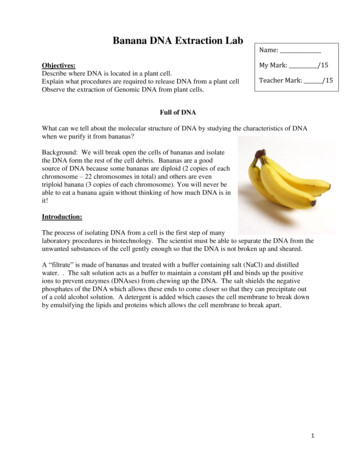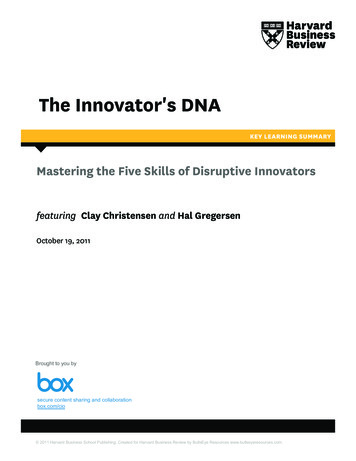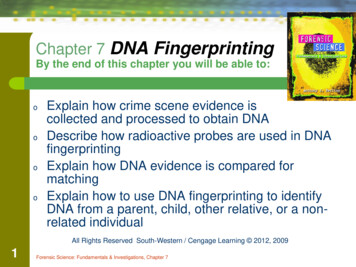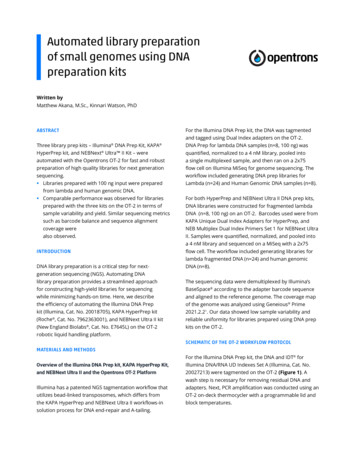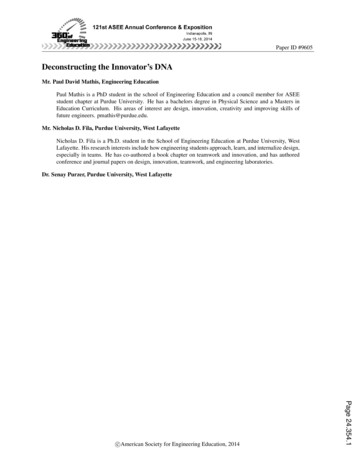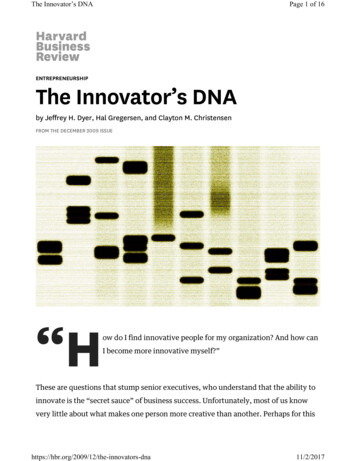
Transcription
The Innovator’s DNAPage 1 of 16ENTREPRENEURSHIPThe Innovator’s DNAby Jeffrey H. Dyer, Hal Gregersen, and Clayton M. ChristensenFROM THE DECEMBER 2009 ISSUE“How do I find innovative people for my organization? And how canI become more innovative myself?”These are questions that stump senior executives, who understand that the ability toinnovate is the “secret sauce” of business success. Unfortunately, most of us knowvery little about what makes one person more creative than another. Perhaps for /2017
The Innovator’s DNAPage 2 of 16reason, we stand in awe of visionary entrepreneurs like Apple’s Steve Jobs, Amazon’sJeff Bezos, eBay’s Pierre Omidyar, and P&G’s A.G. Lafley. How do these people comeup with groundbreaking new ideas? If it were possible to discover the inner workingsof the masters’ minds, what could the rest of us learn about how innovation reallyhappens?In searching for answers, we undertook a six-year study to uncover the origins ofcreative—and often disruptive—business strategies in particularly innovativecompanies. Our goal was to put innovative entrepreneurs under the microscope,examining when and how they came up with the ideas on which their businesseswere built. We especially wanted to examine how they differ from other executivesand entrepreneurs: Someone who buys a McDonald’s franchise may be anentrepreneur, but building an Amazon requires different skills altogether. We studiedthe habits of 25 innovative entrepreneurs and surveyed more than 3,000 executivesand 500 individuals who had started innovative companies or invented new products.We were intrigued to learn that at most companies, top executives do not feelpersonally responsible for coming up with strategic innovations. Rather, they feelresponsible for facilitating the innovation process. In stark contrast, senior executivesof the most innovative companies—a mere 15% in our study—don’t delegate creativework. They do it themselves.But how do they do it? Our research led us to identify five “discovery skills” thatdistinguish the most creative executives: associating, questioning, observing,experimenting, and networking. We found that innovative entrepreneurs (who arealso CEOs) spend 50% more time on these discovery activities than do CEOs with notrack record for innovation. Together, these skills make up what we call theinnovator’s DNA. And the good news is, if you’re not born with it, you can cultivate 2017
The Innovator’s DNAPage 3 of 16What Makes Innovators Different?Innovative entrepreneurs have something called creative intelligence, which enablesdiscovery yet differs from other types of intelligence (as suggested by HowardGardner’s theory of multiple intelligences). It is more than the cognitive skill of beingright-brained. Innovators engage both sides of the brain as they leverage the fivediscovery skills to create new ideas.In thinking about how these skills work together, we’ve found it useful to apply themetaphor of DNA. Associating is like the backbone structure of DNA’s double helix;four patterns of action (questioning, observing, experimenting, and networking) windaround this backbone, helping to cultivate new insights. And just as each person’sphysical DNA is unique, each individual we studied had a unique innovator’s DNA forgenerating breakthrough business ideas.Imagine that you have an identical twin, endowed with the same brains and naturaltalents that you have. You’re both given one week to come up with a creative newbusiness-venture idea. During that week, you come up with ideas alone in your room.In contrast, your twin (1) talks with 10 people—including an engineer, a musician, astay-at-home dad, and a designer—about the venture, (2) visits three innovative startups to observe what they do, (3) samples five “new to the market” products, (4)shows a prototype he’s built to five people, and (5) asks the questions “What if I triedthis?” and “Why do you do that?” at least 10 times each day during these networking,observing, and experimenting activities. Who do you bet will come up with the moreinnovative (and doable) idea?Studies of identical twins separated at birth indicate that our ability to think creativelycomes one-third from genetics; but two-thirds of the innovation skill set comesthrough learning—first understanding a given skill, then practicing it, rs-dna11/2/2017
The Innovator’s DNAPage 4 of 16and ultimately gaining confidence in one’s capacity to create. Innovativeentrepreneurs in our study acquired and honed their innovation skills precisely thisway.Let’s look at the skills in detail.Discovery Skill 1: AssociatingAssociating, or the ability to successfully connect seemingly unrelated questions,problems, or ideas from different fields, is central to the innovator’s DNA.Entrepreneur Frans Johansson described this phenomenon as the “Medici effect,”referring to the creative explosion in Florence when the Medici family broughttogether people from a wide range of disciplines—sculptors, scientists, poets,philosophers, painters, and architects. As these individuals connected, new ideasblossomed at the intersections of their respective fields, thereby spawning theRenaissance, one of the most inventive eras in history.To grasp how associating works, it is important to understand how the brain operates.The brain doesn’t store information like a dictionary, where you can find the word“theater” under the letter “T.” Instead, it associates the word “theater” with anynumber of experiences from our lives. Some of these are logical (“West End” or“intermission”), while others may be less obvious (perhaps “anxiety,” from a botchedperformance in high school). The more diverse our experience and knowledge, themore connections the brain can make. Fresh inputs trigger new associations; forsome, these lead to novel ideas. As Steve Jobs has frequently observed, “Creativity isconnecting things.”The world’s most innovative companies prosper by capitalizing on the divergentassociations of their founders, executives, and employees. For example, PierreOmidyar launched eBay in 1996 after linking three unconnected dots: (1) a dna11/2/2017
The Innovator’s DNAPage 5 of 16with creating more-efficient markets, after having been shut out from a hot internetcompany’s IPO in the mid-1990s; (2) his fiancée’s desire to locate hard-to-findcollectible Pez dispensers; and (3) the ineffectiveness of local classified ads in locatingsuch items. Likewise, Steve Jobs is able to generate idea after idea because he hasspent a lifetime exploring new and unrelated things—the art of calligraphy,meditation practices in an Indian ashram, the fine details of a Mercedes-Benz.Associating is like a mental muscle that can grow stronger by using the otherdiscovery skills. As innovators engage in those behaviors, they build their ability togenerate ideas that can be recombined in new ways. The more frequently people inour study attempted to understand, categorize, and store new knowledge, the moreeasily their brains could naturally and consistently make, store, and recombineassociations.Discovery Skill 2: QuestioningMore than 50 years ago, Peter Drucker described the power of provocative questions.“The important and difficult job is never to find the right answers, it is to find theright question,” he wrote. Innovators constantly ask questions that challengecommon wisdom or, as Tata Group chairman Ratan Tata puts it, “question theunquestionable.” Meg Whitman, former CEO of eBay, has worked directly with anumber of innovative entrepreneurs, including the founders of eBay, PayPal, andSkype. “They get a kick out of screwing up the status quo,” she told us. “They can’tbear it. So they spend a tremendous amount of time thinking about how to change theworld. And as they brainstorm, they like to ask: ‘If we did this, what would happen?’”Most of the innovative entrepreneurs we interviewed could remember the specificquestions they were asking at the time they had the inspiration for a new venture.Michael Dell, for instance, told us that his idea for founding Dell Computer sprangfrom his asking why a computer cost five times as much as the sum of its parts. /2017
The Innovator’s DNAPage 6 of 16would take computers apart and would observe that 600 worth of parts were soldfor 3,000.” In chewing over the question, he hit on his revolutionary businessmodel.To question effectively, innovativeSample of InnovativeEntrepreneurs from ourStudyentrepreneurs do the following:Sam Allen: ScanCafe.comAsk “Why?” and “Why not?” and“What if?”Marc Benioff:Salesforce.comMost managers focus on understandingJeff Bezos: Amazon.comhow to make existing processes—the statusMike Collins: Big Idea Groupquo—work a little better (“How can weScott Cook: IntuitMichael Dell: Dell ComputerAaron Garrity: XanGoimprove widget sales in Taiwan?”).Innovative entrepreneurs, on the otherhand, are much more likely to challengeassumptions (“If we cut the size or weightDiane Green: VMWareof the widget in half, how would thatEliot Jacobsen: RocketFuelchange the value proposition it offers?”).Josh James: OmnitureMarc Benioff, the founder of the onlineChris Johnson: Terra Novasales software provider Salesforce.com,Jeff Jones: NxLight; CampusPipelinewas full of questions after witnessing theHerb Kelleher: Southwest Airlinescompanies built on services delivered viaMike Lazaridis: Research In Motionthe internet. “Why are we still loading andSpencer Moffat: Fast Arch of UtahDavid Neeleman: JetBlue; MorrisAirPierre Omidyar: eBayJohn Pestana: emergence of Amazon and eBay, twoupgrading software the way we’ve beendoing all this time when we can now do itover the internet?” he wondered. Thisfundamental question was the genesis ofSalesforce.com.11/2/2017
The Innovator’s DNAPage 7 of 16Peter Thiel: PayPalImagine opposites.Mark Wattles: Hollywood VideoIn his book The Opposable Mind, RogerCorey Wride: Movie MouthMartin writes that innovative thinkersNiklas ZennstrÖm: Skypehave “the capacity to hold twodiametrically opposing ideas in theirheads.” He explains, “Without panickingor simply settling for one alternative or theother, they’re able to produce a synthesis that is superior to either opposing idea.”Innovative entrepreneurs like to play devil’s advocate. “My learning process hasalways been about disagreeing with what I’m being told and taking the oppositeposition, and pushing others to really justify themselves,” Pierre Omidyar told us. “Iremember it was very frustrating for the other kids when I would do this.” Askingoneself, or others, to imagine a completely different alternative can lead to trulyoriginal insights.Embrace constraints.Most of us impose constraints on our thinking only when forced to deal with realworld limitations, such as resource allocations or technology restrictions. Ironically,great questions actively impose constraints on our thinking and serve as a catalyst forout-of-the-box insights. (In fact, one of Google’s nine innovation principles is“Creativity loves constraint.”) To initiate a creative discussion about growthopportunities, one innovative executive in our study asked this question: “What if wewere legally prohibited from selling to our current customers? How would we makemoney next year?” This led to an insightful exploration of ways the company couldfind and serve new customers. Another innovative CEO prods his managers toexamine sunk-cost constraints by asking, “What if you had not already hired thisperson, installed this equipment, implemented this process, bought this business, orpursued this strategy? Would you do the same thing you are doing a11/2/2017
The Innovator’s DNAPage 8 of 16Discovery Skill 3: ObservingDiscovery-driven executives produce uncommon business ideas by scrutinizingcommon phenomena, particularly the behavior of potential customers. In observingothers, they act like anthropologists and social scientists.Intuit founder Scott Cook hit on the idea for Quicken financial software after two keyobservations. First he watched his wife’s frustration as she struggled to keep track oftheir finances. “Often the surprises that lead to new business ideas come fromwatching other people work and live their normal lives,” Cook explained. “You seesomething and ask, ‘Why do they do that? That doesn’t make sense.’” Then a buddygot him a sneak peek at the Apple Lisa before it launched. Immediately after leavingApple headquarters, Cook drove to the nearest restaurant to write down everythinghe had noticed about the Lisa. His observations prompted insights such as buildingthe graphical user interface to look just like its real-world counterpart (a checkbook,for example), making it easy for people to use it. So Cook set about solving his wife’sproblem and grabbed 50% of the market for financial software in the first year.Innovators carefully, intentionally, and consistently look out for small behavioraldetails—in the activities of customers, suppliers, and other companies—in order togain insights about new ways of doing things. Ratan Tata got the inspiration that ledto the world’s cheapest car by observing the plight of a family of four packed onto asingle motorized scooter. After years of product development, Tata Group launchedin 2009 the 2,500 Nano using a modular production method that may disrupt theentire automobile distribution system in India. Observers try all sorts of techniques tosee the world in a different light. Akio Toyoda regularly practices Toyota’s philosophyof genchi genbutsu—“going to the spot and seeing for yourself.” Frequent directobservation is baked into the Toyota culture.Discovery Skill 4: s-dna11/2/2017
The Innovator’s DNAPage 9 of 16When we think of experiments, we think of scientists in white coats or of greatinventors like Thomas Edison. Like scientists, innovative entrepreneurs actively tryout new ideas by creating prototypes and launching pilots. (As Edison said, “I haven’tfailed. I’ve simply found 10,000 ways that do not work.”) The world is theirlaboratory. Unlike observers, who intensely watch the world, experimenters constructinteractive experiences and try to provoke unorthodox responses to see what insightsemerge.The innovative entrepreneurs we interviewed all engaged in some form of activeexperimentation, whether it was intellectual exploration (Michael Lazaridis mullingover the theory of relativity in high school), physical tinkering (Jeff Bezos taking aparthis crib as a toddler or Steve Jobs disassembling a Sony Walkman), or engagement innew surroundings (Starbucks founder Howard Shultz roaming Italy visiting coffeebars). As executives of innovative enterprises, they make experimentation central toeverything they do. Bezos’s online bookstore didn’t stay where it was after its initialsuccess; it morphed into an online discount retailer, selling a full line of products fromtoys to TVs to home appliances. The electronic reader Kindle is an experiment that isnow transforming Amazon from an online retailer to an innovative electronicsmanufacturer. Bezos sees experimentation as so critical to innovation that he hasinstitutionalized it at Amazon. “I encourage our employees to go down blind alleysand experiment,” Bezos says. “If we can get processes decentralized so that we can doa lot of experiments without it being very costly, we’ll get a lot more innovation.”Scott Cook, too, stresses the importance ofHow Innovators Stack UpThis chart shows how four wellknown innovative entrepreneursrank on each of the discovery skills.All our high-profile innovatorsscored above the 80th nacreating a culture that fostersexperimentation. “Our culture opens us toallowing lots of failures while harvesting11/2/2017
The Innovator’s DNAon questioning, yet each combinedthe discovery skills uniquely toforge new insights.Page 10 of 16the learning,” he told us. “It’s whatseparates an innovation culture from anormal corporate culture.”One of the most powerful experimentsinnovators can engage in is living andworking overseas. Our research revealedRankings are based on a survey ofmore than 3,000 executives andentrepreneurs.that the more countries a person has livedin, the more likely he or she is to leveragethat experience to deliver innovativeproducts, processes, or businesses. In fact,if managers try out even one internationalassignment before becoming CEO, their companies deliver stronger financial resultsthan companies run by CEOs without such experience—roughly 7% higher marketperformance on average, according to research by Gregeren, Mason A. Carpenter, andGerard W. Sanders. P&G’s A.G. Lafley, for example, spent time as a student studyinghistory in France and running retail operations on U.S. military bases in Japan. Hereturned to Japan later to head all of P&G’s Asia operations before becoming CEO. Hisdiverse international experience has served him well as the leader of one of the mostinnovative companies in the world.Discovery Skill 5: NetworkingDevoting time and energy to finding and testing ideas through a network of diverseindividuals gives innovators a radically different perspective. Unlike mostexecutives—who network to access resources, to sell themselves or their companies,or to boost their careers—innovative entrepreneurs go out of their way to meet peoplewith different kinds of ideas and perspectives to extend their own knowledgedomains. To this end, they make a conscious effort to visit other countries and meetpeople from other walks of 2/2017
The Innovator’s DNAPage 11 of 16They also attend idea conferences such as Technology, Entertainment, and Design(TED), Davos, and the Aspen Ideas Festival. Such conferences draw together artists,entrepreneurs, academics, politicians, adventurers, scientists, and thinkers from allover the world, who come to present their newest ideas, passions, and projects.Michael Lazaridis, the founder of Research In Motion, notes that the inspiration forthe original BlackBerry occurred at a conference in 1987. A speaker was describing awireless data system that had been designed for Coke; it allowed vending machines tosend a signal when they needed refilling. “That’s when it hit me,” Lazaridis recalls. “Iremembered what my teacher said in high school: ‘Don’t get too caught up withcomputers because the person that puts wireless technology and computers togetheris going to make a big difference.’” David Neeleman came up with key ideas forJetBlue—such as satellite TV at every seat and at-home reservationists—throughnetworking at conferences and elsewhere.Kent Bowen, the founding scientist of CPS technologies (maker of an innovativeceramic composite), hung the following credo in every office of his start-up: “Theinsights required to solve many of our most challenging problems come from outsideour industry and scientific field. We must aggressively and proudly incorporate intoour work findings and advances which were not invented here.” Scientists from CPShave solved numerous complex problems by talking with people in other fields. Oneexpert from Polaroid with in-depth knowledge of film technology knew how to makethe ceramic composite stronger. Experts in sperm-freezing technology knew how toprevent ice crystal growth on cells during freezing, a technique that CPS applied to itsmanufacturing process with stunning success.Practice, Practice, PracticePut a Ding in the UniverseWhy do innovators question,observe, experiment, and networkmore than typical executives? As wehttps://hbr.org/2009/12/the-innovators-dnaAs innovators actively engage in thediscovery skills, they become defined bythem. They grow increasingly confident of11/2/2017
The Innovator’s DNAPage 12 of 16examined what motivates them, wediscovered two common themes:(1) They actively desire to changethe status quo, and (2) theyregularly take risks to make thatchange happen. Throughout ourresearch, we were struck by theconsistency of language thatinnovators use to describe theirmotives. Jeff Bezos wants to “makehistory,” Steve Jobs to “put a dingin the universe,” Skype cofounderNiklas Zennström to “be disruptive,but in the cause of making theworld a better place.” Theseinnovators steer entirely clear of acommon cognitive bias called thestatus quo bias—the tendency toprefer an existing state of affairs toalternative ones.their creative abilities. For A.G. Lafley,Embracing a mission for changemakes it much easier to take risksand make mistakes. For most of theinnovative entrepreneurs westudied, mistakes are nothing to beashamed of; in fact, they areexpected as a cost of doingbusiness. “If the people runningAmazon.com don’t make somesignificant mistakes,” explainedBezos, “then we won’t be doing agood job for our shareholdersbecause we won’t be swinging forthe fences.” In short, innovatorsrely on their “courage toinnovate”—an active bias againstthe status quo and an unflinchingactively cultivate more creative novation is the central job of everyleader, regardless of the place he or sheoccupies on the organizational chart. Butwhat if you—like most executives—don’tsee yourself or those on your team asparticularly innovative?Though innovative thinking may be innateto some, it can also be developed andstrengthened through practice. We cannotemphasize enough the importance ofrehearsing over and over the behaviorsdescribed above, to the point that theybecome automatic. This requires puttingaside time for you and your team toThe most important skill to practice isquestioning. Asking “Why” and “Why not”can help turbocharge the other discoveryskills. Ask questions that both impose andeliminate constraints; this will help yousee a problem or opportunity from adifferent angle. Try spending 15 to 30minutes each day writing down 10 newquestions that challenge the status quo inyour company or industry. “If I had afavorite question to ask, everyone would11/2/2017
The Innovator’s DNAwillingness to take risks—totransform ideas into powerfulimpact.Page 13 of 16anticipate it,” Michael Dell told us.“Instead I like to ask things people don’tthink I’m going to ask. This is a little cruel,but I kind of delight in coming up withquestions that nobody has the answer toquite yet.”To sharpen your own observational skills, watch how certain customers experience aproduct or service in their natural environment. Spend an entire day carefullyobserving the “jobs” that customers are trying to get done. Try not to make judgmentsabout what you see: Simply pretend you’re a fly on the wall, and observe as neutrallyas possible. Scott Cook advises Intuit’s observers to ask, “What’s different than youexpected?” Follow Richard Branson’s example and get in the habit of note takingwherever you go. Or follow Jeff Bezos’s: “I take pictures of really bad innovations,” hetold us, “of which there are a number.”To strengthen experimentation, at both the individual and organizational levels,consciously approach work and life with a hypothesis-testing mind-set. Attendseminars or executive education courses on topics outside your area of expertise; takeapart a product or process that interests you; read books that purport to identifyemerging trends. When you travel, don’t squander the opportunity to learn aboutdifferent lifestyles and local behavior. Develop new hypotheses from the knowledgeyou’ve acquired and test them in the search for new products or processes. Find waysto institutionalize frequent, small experiments at all levels of the organization.Openly acknowledging that learning through failure is valuable goes a long waytoward building an innovative 11/2/2017
The Innovator’s DNAPage 14 of 16Try spending 15 to 30 minutes each daywriting down questions that challengethe status quo in your company.To improve your networking skills, contact the five most creative people you knowand ask them to share what they do to stimulate creative thinking. You might also askif they’d be willing to act as your creative mentors. We suggest holding regular idealunches at which you meet a few new people from diverse functions, companies,industries, or countries. Get them to tell you about their innovative ideas and ask forfeedback on yours. Innovative entrepreneurship is not a genetic predisposition, it is an active endeavor.Apple’s slogan “Think Different” is inspiring but incomplete. We found thatinnovators must consistently act different to think different. By understanding,reinforcing, and modeling the innovator’s DNA, companies can find ways to moresuccessfully develop the creative spark in everyone.A version of this article appeared in the December 2009 issue of Harvard Business Review.Jeffrey H. Dyer is the Horace Beesley Professor of Strategy at Brigham YoungUniversity’s Marriott 1/2/2017
The Innovator’s DNAPage 15 of 16Hal Gregersen is executive director of the MIT Leadership Center, a seniorlecturer in leadership and innovation at the MIT Sloan School of Management, andthe founder of the 4-24 Project. A Thinkers50 globally ranked management thinker,he is the co-author The Innovator’s DNA: Mastering the Five Skills of DisruptiveInnovators. He also co-creator (with Sam Abell) of Leadership and the Lens:Learning at the Intersection of Innovation and Image-Making, a unique executive education experiencedelivered by MIT Sloan Executive Education in association with Santa Fe Photographic Workshops.Clayton M. Christensen is the Kim B. Clark Professor of BusinessAdministration at Harvard Business School.This article is about ENTREPRENEURSHIP FOLLOW THIS TOPICRelated Topics: CREATIVITY DISRUPTIVE INNOVATIONCommentsLeave a CommentPOST13 COMMENTSReza Nassabeh24 days 2017
The Innovator’s DNAPage 16 of 16Great article! I respectfully disagree though that the ability to innovate is the “secret sauce” ofbusiness success. In my view, it is the core element of business success in today's highly competitivemarkets. In the past one could start a business and differentiate it by implementing a few innovativeideas but today, it's had to imagine a successful business without innovation being an integral partof it.0 0 REPLY JOIN THE CONVERSATIONPOSTING GUIDELINESWe hope the conversations that take place on HBR.org will be energetic, constructive, and thought-provoking. To comment,readers must sign in or register. And to ensure the quality of the discussion, our moderating team will review all comments and mayedit them for clarity, length, and relevance. Comments that are overly promotional, mean-spirited, or off-topic may be deleted perthe moderators' judgment. All postings become the property of Harvard Business dna11/2/2017
metaphor of DNA. Associating is like the backbone structure of DNA's double helix; four patterns of action (questioning, observing, experimenting, and networking) wind around this backbone, helping to cultivate new insights. And just as each person's physical DNA is unique, each individual we studied had a unique innovator's DNA for


